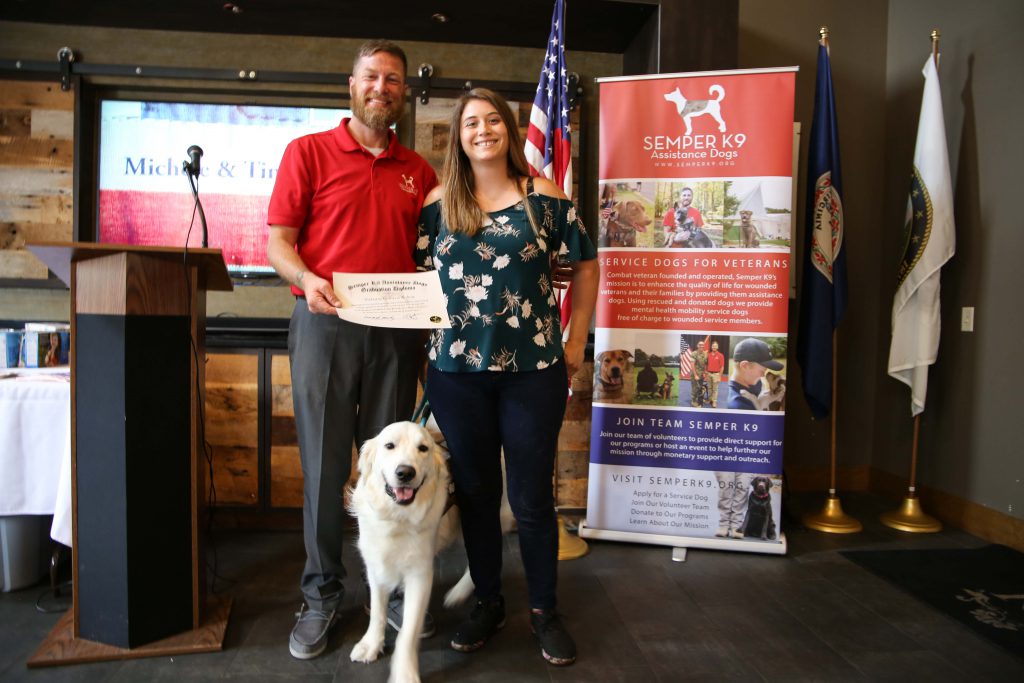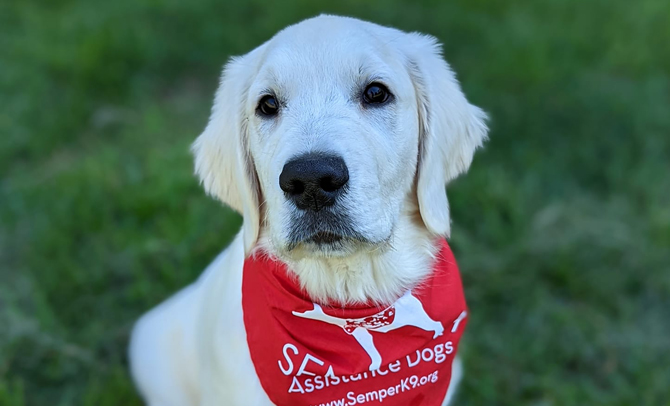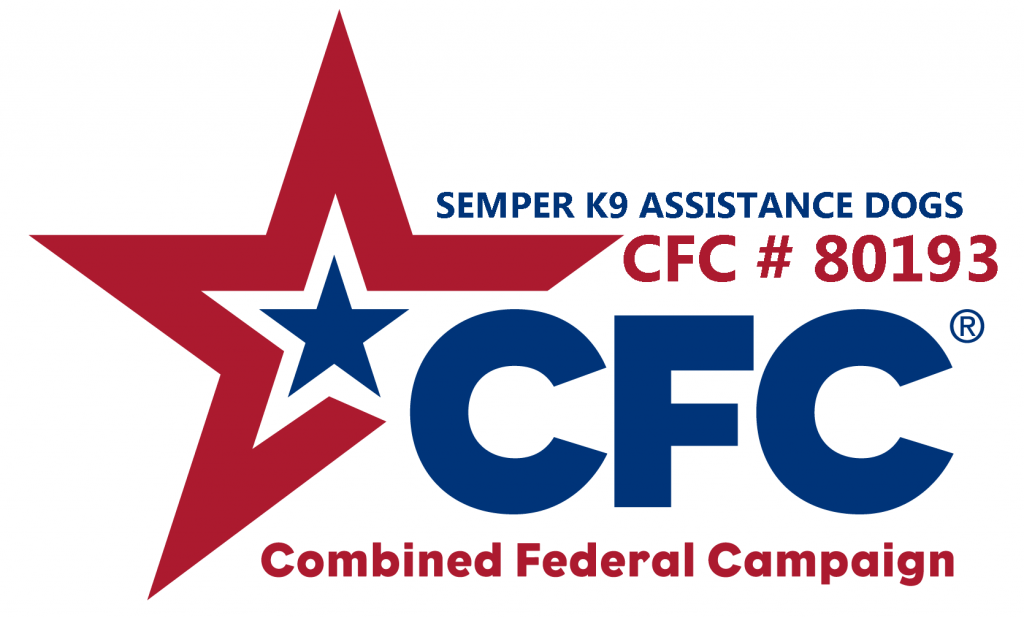Ace
Semper K9 is honored to announce the acceptance of Ace into our Service Dogs for Veterans program. Ace is a Golden Retriever donated by Helen Findlay of Providence Farms in Rixeyville, Virginia. Ace is named in memory of Major Dick “Ace of Aces” Bong, United States Air Force.
 Before the fictional Top Gun movie about a wild maverick pilot, there was the real rebel, a WWII hero known as the “Ace of Aces” Dick Bong. Richard “Dick” Ira Bong (September 24, 1920 – August 6, 1945) was a United States Army Air Forces major and Medal of Honor, recipient in World War II. He was one of the most decorated American fighter pilots and the country’s top flying ace in the war, credited with shooting down 40 Japanese aircraft, all with the Lockheed P-38 Lightning fighter. He died in California while testing a Lockheed P-80 jet fighter shortly before the war ended. Bong was posthumously inducted into the National Aviation Hall of Fame in 1986 and had several commemorative monuments named in his honor around the world, including an airport, two bridges, a theater, a historical veterans center, a recreation area, a neighborhood terrace, and several avenues and streets, including the street leading to the National Museum of the United States Air Force in Dayton, Ohio.
Before the fictional Top Gun movie about a wild maverick pilot, there was the real rebel, a WWII hero known as the “Ace of Aces” Dick Bong. Richard “Dick” Ira Bong (September 24, 1920 – August 6, 1945) was a United States Army Air Forces major and Medal of Honor, recipient in World War II. He was one of the most decorated American fighter pilots and the country’s top flying ace in the war, credited with shooting down 40 Japanese aircraft, all with the Lockheed P-38 Lightning fighter. He died in California while testing a Lockheed P-80 jet fighter shortly before the war ended. Bong was posthumously inducted into the National Aviation Hall of Fame in 1986 and had several commemorative monuments named in his honor around the world, including an airport, two bridges, a theater, a historical veterans center, a recreation area, a neighborhood terrace, and several avenues and streets, including the street leading to the National Museum of the United States Air Force in Dayton, Ohio.
Bong’s ability as a fighter pilot was recognized while he was training in northern California. He was commissioned a second lieutenant and awarded his pilot wings on January 19, 1942. His first assignment was as an instructor (gunnery) pilot at Luke Field, Arizona, from January to May 1942. His first operational assignment was on May 6 to the 49th Fighter Squadron (FS), 14th Fighter Group at Hamilton Field, California, where he learned to fly the twin-engine Lockheed P-38 Lightning.
On June 12, 1942, Bong flew very low (“buzzed”) over a house in nearby San Anselmo, the home of a pilot who had just been married. He was cited and temporarily grounded for breaking flying rules, along with three other P-38 pilots who had looped around the Golden Gate Bridge on the same day. For looping the Golden Gate Bridge, flying at a low level down Market Street in San Francisco, and blowing the clothes off of an Oakland woman’s clothesline, Bong was reprimanded by General George C. Kenney, commanding officer of the Fourth Air Force, who told him, “If you didn’t want to fly down Market Street, I wouldn’t have you in my Air Force, but you are not to do it any more and I mean what I say.” Kenney later wrote, “We needed kids like this lad.”
In all subsequent accounts, Bong denied flying under the Golden Gate Bridge. Nevertheless, Bong was still grounded when the rest of his group was sent without him to England in July 1942. Bong then transferred to another Hamilton Field unit, 84th Fighter Squadron of the 78th Fighter Group. From there, Bong was sent to the Southwest Pacific Area.

Bong was then flown overseas as a passenger aboard a B-24 Liberator from Hawaii via Hickam Field to Australia. Upon arrival Bong was assigned to a newly formed P-38 fighter unit, the 17th Fighter Squadron (Provisional). By November 1942 Bong was transferred to the 49th Fighter Group (49th FG), 9th Fighter Squadron (9th FS). “The Flying Knights” were flying the P-40 Warhawk and were famous for their aerial defense of Darwin from March 1942 until August 1942. Afterwards, the 9th Fighter Squadron was one of two units in the 5th Air Force selected for conversion to the P-38 Lightning. Bong was among a group of new pilots in the South-West Pacific Area (SWPA) with experience flying the new twin engine fighter, and they helped these pilots convert from the P-40 Warhawk and P-39 Airacobra to the P-38 Lightning.
In November, while the squadron waited for delivery of the scarce P-38s, Bong and other 9th FS pilots were reassigned temporarily to fly missions and gain combat experience with the 39th Fighter Squadron, 35th Fighter Group, based in Port Moresby, New Guinea. On December 27, Bong claimed his initial aerial victory, shooting down a Mitsubishi A6M “Zero”, and a Nakajima Ki-43 “Oscar” over Buna (during the Battle of Buna-Gona). For this action, Bong was awarded the Silver Star.
Bong rejoined the 9th FS, by then equipped with P-38s, in January 1943; the 49th FG was based at Schwimmer Field near Port Moresby. In April, he was promoted to first lieutenant. On July 26, Bong claimed four Japanese fighters over Lae, in an action that earned him the Distinguished Service Cross. In August, he was promoted to captain.
While on leave to the United States the following November and December, Bong met Marjorie Vattendahl at a Superior State Teachers’ College homecoming event and began dating her.
After returning to the southwest Pacific in January 1944, he named his P-38 “Marge” and adorned the nose with her photo. On April 12, Captain Bong shot down his 26th and 27th Japanese aircraft, surpassing Eddie Rickenbacker’s American record of 26 credited victories in World War I. Soon afterwards, he was promoted to major by General Kenney and dispatched to the United States to see General “Hap” Arnold, who gave him a leave.
After visiting training bases and going on a 15-state bond promotion tour, Bong returned to New Guinea in September. He was assigned to the V Fighter Command staff as an advanced gunnery instructor with permission to go on missions but not to seek combat. Bong continued flying from Tacloban, Leyte, during the Philippines campaign; by December 17, he had increased his air-to-air victory claims to 40.
Bong considered his gunnery accuracy to be poor, so he compensated by getting as close to his targets as possible to make sure he hit them. In some cases he flew through the debris of exploding enemy aircraft, and on one occasion collided with his target, which he claimed as a “probable” victory.
In the recommendation of General Kenney, the Far East Air Force commander, Bong received the Medal of Honor from General Douglas MacArthur in a special ceremony in December 1944. Bong’s Medal of Honor citation says that he flew combat missions despite his status as an instructor, which was one of his duties as standardization officer for V Fighter Command. His rank of major would have qualified him for a squadron command, but he always flew as a flight (four-plane) or element (two-plane) leader.
In January 1945, Kenney sent America’s ace of aces home for good. Bong married Vattendahl on February 10, 1945. He participated in numerous PR activities, such as promoting the sale of war bonds.
Bong then became a test pilot assigned to Lockheed’s plant in Burbank, California, where he flew P-80 Shooting Star jet fighters at the Lockheed Air Terminal. On August 6, 1945, he took off to perform the acceptance flight of P-80A 44-85048. It was his 12th flight in the P-80; he had a total of four hours and fifteen minutes of flight time in the jet.
The plane’s primary fuel pump malfunctioned during takeoff. Bong either forgot to switch to the auxiliary fuel pump, or for some reason was unable to do so. Bong cleared away from the aircraft, but was too low for his parachute to deploy. The plane crashed into a narrow field at Oxnard Street and Satsuma Avenue, North Hollywood. His death was front-page news across the country, sharing space with the first news of the bombing of Hiroshima.
His death was featured prominently in national newspapers, even though it occurred on the same day as the atomic bombing of Hiroshima.
The I-16 fuel pump had been added to P-80s after an earlier fatal crash. Captain Ray Crawford, a fellow P-80 test/acceptance flight pilot who flew on August 6, later said Bong had told him that he had forgotten to turn on the I-16 pump on an earlier flight.
In his autobiography, Chuck Yeager writes that part of the culture of test flying at the time, due to its fearsome mortality rates, was anger toward pilots who died in test flights, to avoid being overcome by sorrow for lost comrades. Bong’s brother Carl, who wrote his biography, questions whether Bong repeated the mistake so soon after mentioning it to another pilot. Carl’s book – Dear Mom, So We Have a War (1991) – contains numerous reports and findings from the crash investigations.
In the mid-1950s, construction on a new USAF installation commenced south of Milwaukee that was to be named Richard I. Bong Air Force Base. The base, intended to be an Air Defense Command fighter base for the Chicago and Milwaukee areas, was conceived in the early 1950s with construction commencing in the mid-1950s. Construction had barely begun when the base was transferred to the Strategic Air Command as a prospective base for the supersonic B-58 Hustler bomber. Prior to completion, the base was considered obsolete as it had become apparent to USAF officials that the base would be redundant with installations nearby that would soon have space for more units. The base was abandoned in 1959 and disposed of the following year. Today, the former base site is known as the Richard Bong State Recreation Area.
This base is not to be confused with the planned renaming of Spokane Air Force Base, Washington, as Bong Air Force Base, which was the planned name of that facility until General Muir Fairchild died on active duty in 1950, cementing “Fairchild” onto the name of the current Fairchild Air Force Base. Bog is buried at Poplar Cemetery in Poplar, Wisconsin.
If you would like to make a memorial gift in honor of Major Bong to benefit Ace’s training & expenses, please visit http://donate.semperk9.org.






